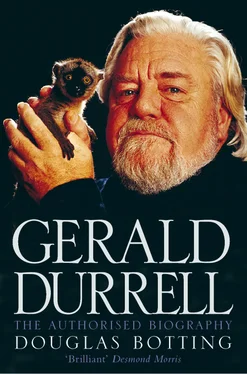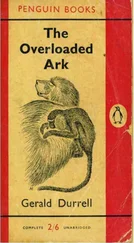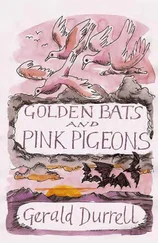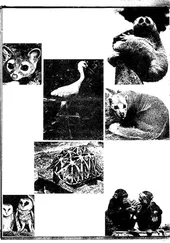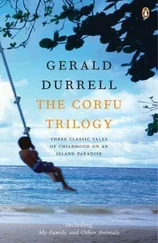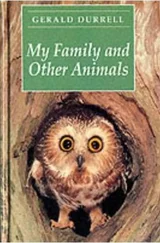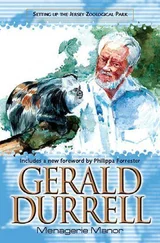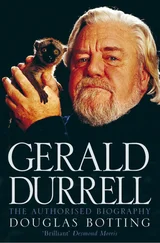I went down to the office and there stood a fair-haired boy with a nice, open, friendly face, wearing an open-necked white shirt with the sleeves rolled up. He was taller than me, about five foot eight or so, and he had bright blue eyes, I remember. I said: ‘What’s your name?’ and he said: ‘You can call me Gerry or Durrell.’ So I said: ‘Gerry will do. Get a bike and follow me.’ As we rode along I asked him: ‘Why aren’t you in the forces?’ and he explained that he was a Greek citizen and that he wanted to be a big animal collector one day, which I treated with a pinch of salt. I took him to see the huskies and showed him around and after that we became good friends and got to know each other very well.
Though Gerald was officially described as a ‘student keeper’, his real role was that of ‘odd-beast boy’, at the very bottom of the heap in terms of status. But by dint of his personality he defied all conventional classification among his friends and colleagues at the zoo. The odd-beast boy was at everyone’s disposal, and could be assigned to any task with any creature, big or little, docile or lethal. In terms of learning the ropes at a premier zoo – the hands-on care of large and dangerous animals (including lions and tigers, bears and buffalo), daily routine and standard zoo practice – the job was exactly what Gerald wanted. But he wanted to learn more than that.
Gerald continued his voracious reading, but now he focused his interest much more on zoo business. Almost without exception, he realised, most of the world’s zoos since Victorian times had served merely as peep-shows, places of public entertainment, where people went to be amused in much the same spirit that their ancestors used to visit lunatic asylums. Scientific research at most zoos was virtually nil, and if an animal died it was simply replaced from what was taken to be Nature’s unending bounty. Before long, it dawned on Gerald that this bounty was in fact being rapidly exhausted:
As I pursued my reading, I began to learn with horror of man’s rapacious encroachment upon the world and the terrible devastation that he was producing among animal life. I read of the dodo, flightless and harmless, discovered and exterminated in almost the same breath. I read of the passenger pigeon in North America, whose vast numbers darkened the sky, who were so numerous that their nesting colonies measured several hundred square miles. They were good to eat; the last one died in Cincinnati Zoo in 1914. The quagga, that strange half horse, half zebra once so common in South Africa, was harried to extinction by the Boer farmers; the last one died in London Zoo in 1909. It seemed incredible, almost impossible, that people in charge of zoos should have been so ignorant that they did not realise that these animals were tottering on the border of extinction and that they did not do something about it. Surely this was one of the true functions of a zoological garden, to help animals that were being pushed towards extinction?
Jill Johnson remembered Gerald saying, ‘A lot of animals are going to become extinct. Wouldn’t it be wonderful if one could breed these animals and put them back where they came from?’ But then he would have doubts, and remark: ‘Perhaps they’re becoming extinct because they’re meant to, because the world is changing. Perhaps they’re becoming extinct like the sabre-toothed tiger became extinct, because it’s in the order of things, because they’re meant to be replaced by something else.’ But was it in the order of things for one species to commit biocide against all the others? For man to take it into his own hands to speed half the animal kingdom to extinction? Sixty million buffalo once trampled the Great Plains of America – the greatest animal congregation that ever existed on earth. Then the white man came and began to kill them off at the rate of a million a year, so that by the 1880s there were just twenty left in the whole USA. A man could ride a thousand miles across the plains and never be out of sight of a dead buffalo and never in sight of a living one. Was that in the order of things? Nothing in Gerald’s life so far gave him greater insight into the acuteness of this problem, and its potential solution, than his encounter with Père David’s deer.
Père David’s deer had provided the world with a classic case of near-extinction and captive breeding undertaken by default. A distant relative of the red deer, it was once widespread in China, but by the end of the nineteenth century it had been hunted almost to extinction, and during the Boxer Rebellion in 1900 the few that remained were killed in the emperor’s garden in Peking. Or so it seemed. As it happened, before their total extinction in their natural homeland a few specimens had been sent to Woburn Park, not far from Whipsnade, by an English aristocrat, the Duke of Bedford. From this small group the numbers of the almost vanished species were increased by haphazard natural breeding in captivity to a point where Père David’s deer can now be found all over the world. Gerald was well aware of this extraordinary story, and he was fascinated when four newborn specimens of the famous deer – still rare at that time – were sent to Whipsnade to be hand-reared:
They were delightful little things with long gangling limbs over which they had no control, and strange slanted eyes that gave them a distinctly oriental appearance … They had to be fed once during the night, at midnight, and again at dawn … I must say I rather enjoyed the night duties. To pick one’s way through the moonlit park towards the stable where the baby deer were kept, you had to pass several of the cages and paddocks, and the occupants were always on the move. The bears, looking twice as big in the half light, would be snorting to each other as they shambled heavily through the riot of brambles in their cage. At one point the path led through the wolf wood, with the moonlight silvering the trunks and laying dark shadows along the ground through which the wolf pack danced on swift, silent feet, like a strange black tide, swirling and twisting among the trunks.
Then you’d reach the stable and light the lantern. The baby deer would start moving restlessly in their straw beds, bleating tremulously. As you opened the door they’d rush forward, wobbling on their unsteady legs, sucking frantically at your fingers or the edge of your coat, and butting you suddenly in the legs with their heads, so that you were almost knocked down. Then came the exquisite moment when the teat was pushed into their mouths and they sucked frantically at the warm milk, their eyes staring, bubbles gathering like a moustache at the corners of their mouths. In the flickering light of the lantern, while the deer sucked and slobbered over the bottles, I was very conscious of the fact that they were the last of their kind, animal refugees living a precarious existence on the edge of extermination, dependent for their existence on the charity of a handful of human beings.
Jill Johnson was Gerald’s partner in this operation. She recalled:
I used to milk the goats, and Gerry used to take the bottle of goat milk to feed the deer. But it was a bit of a nuisance doing it this way, because the deer kept swallowing the teats. So one day we decided to take the nanny goat in to the deer so that they could suck from her direct. This worked pretty well when the deer were small, but eventually they grew bigger than the nanny and would butt under her and lift her up in the air, legs sprawling, and feed from her like that …
After that venture we moved on to looking after sick and orphaned animals, and were even allowed to help with operations by the vet. But the Père David’s deer may well have given Gerry his first glimpse into the possibilities of captive breeding. We used to talk about them perhaps breeding in the Park and then being reintroduced into China. It was just a dream then, but later it did happen.
Читать дальше
